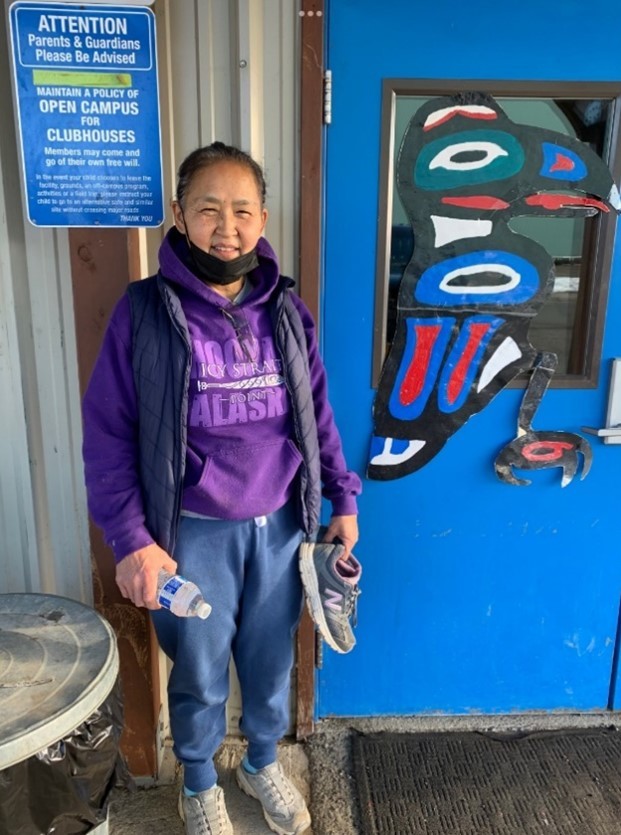Hoonah Steps Out
Aerial view of Hoonah, Alaska
You may be familiar with the old saying that a journey of a thousand miles begins with a single step. It’s an observation attributed to the ancient Chinese philosopher, Lao Tzu.
In Hoonah these days, that expression comes with a bit of a twist. In this small Tlingit community located on Chichagof Island in the Alaska panhandle, a month-long journey of more than a million steps began with one great idea from a team of community leaders, including the public health nurse, who were determined to get town residents moving towards healthier lifestyles.
Back in 2012, long before COVID-19, Sonja Engle was pondering what could be done to address obesity in Hoonah, which then had about 700 residents and is now home to about 800 people. Obesity is a problem both nationwide and in Alaska. Results from the 2020 Alaska Behavioral Risk Factor Surveillance System found that 34.6% of Alaskan adults are overweight and 32% are obese. The reality of modern American life – where our airwaves are filled with commercials pitching salty snacks, candy treats, and sugary drinks of all sorts – is compounded by isolation and challenging weather that can create barriers to healthy lifestyles in many of Alaska’s communities.
In communities like Hoonah, winters can be long and hard, and opportunities for indoor exercise options may be limited. Sonja and the team— which included local teachers, volunteer organizations, civic officials and members of the Hoonah Indian Association — wanted to make Hoonah healthier by inspiring people to make lasting behavior change, not by telling people to lose weight or ban certain foods.
The group sought out useful resources to bolster their case. This led them to the Center for Disease Control and Prevention’s website and eventually to the Community Guide, a free resource developed by the Community Preventive Services Task Force, an independent, nonfederal, volunteer group of public health experts. The Guide outlines a plethora of disease prevention and behavior change strategies based on empirical data and scientific findings.
“It was exactly what I needed, because it helped us assess Hoonah’s needs and create a plan that best fit what our community is like,” says Sonja. “It gave validity to some of the things we were brainstorming already. We could point to what experts were saying.”
With the Community Guide as their health and fitness North Star, Sonja and Hoonah’s like-minded residents would center their efforts on two major goals: reducing obesity and increasing access to nutritional foods.
A Walking Challenge, Healthier School Lunches and More
That led to the creation of the month-long walking challenge that encouraged dozens of Hoonah residents to lace up their sneakers and start taking those important first steps toward a more active lifestyle. But participants could do more than walk for credit; Sonja’s team provided an activity chart that converted other physical tasks, such as chopping wood or playing basketball, into steps. In addition, the team monitored participant’s blood pressure and heart rates. The challenge also included a Ravens moiety vs. Eagles moiety contest that pitted the two lineages or clans in friendly, but heated competition for fitness bragging rights.
 Top Raven walker, Debbie Picken
Another top priority of the team was to bring locally-caught seafood to school kitchens. Salmon, halibut and cod from nearby shores provided a highly nutritious addition to school menus, and the cooks did a stellar job incorporating these Alaska staples into creative and tasty lunchtime choices for students. Sally Dybdahl, who worked with Sonja and other community advocates in the early days of the effort says, with a chuckle, “I’ve had parents tell me their kids think school meals are too healthy these days.”
In addition to those two efforts, the team also worked to expand hours at the local recreational center, reopen a community pool, start a community garden and build a new playground for the community. All those initiatives are still going strong, although the walking challenge was temporarily interrupted by COVID.
Revitalizing the Walking Challenge
As the pandemic waned in the first few months of 2022, Hoonah and its citizens revitalized their walking challenge, with many of the first walkers from a decade ago once again pounding the pavement and breaking sweats in an array of invigorating ways.
“We received many positive comments,” notes Nancy Snyder, the public health nurse who succeeded Sonja in the position. “And a lot of those who didn’t take part regretted not getting in on the action and asked if we’re planning to do it again. We are, and we’re going to make it an annual event every February to March.”
Veterans Memorial Sea Walk in Hoonah
Hoonah teenager Dietrich Lewis took the top prize this year, compiling an incredible 1,215,880 steps. He walks everywhere, because his family doesn’t own a car, and Dietrich spent many hours swimming, doing boat checks, jumping on a trampoline, and wrestling. The next closest challenge participant logged a total of 843,923 steps. Overall, 41 faithful Ravens and Eagles took 10,617,164 steps during the 28-day challenge.
Raven Eagle Walking Challenge past winning teams
Today, Hoonah has maintained the momentum Sonja’s team began 10 years ago when they turned to the pages of the Community Guide, but there’s more work to do. Work is now turning to community factors that provide the underpinning for improved health.
“There’s a lot more in the works and many issues that need to be addressed,” Nancy says. “From mental health issues, compounded during the pandemic months of isolation, to meeting growing demands for affordable housing, energy and electricity. All of that is needed to help support healthy lifestyles.”
With dedicated community advocates and a foundation established through follow-through and focus, Hoonah’s journey to its future is bright. Hoonah is stepping out every day – and stepping up to challenges!
View of Hoonah from the sea.
More tips from DHSS Insights
|